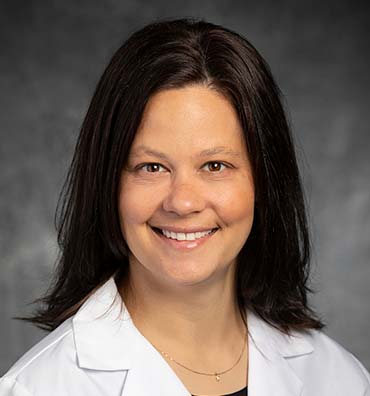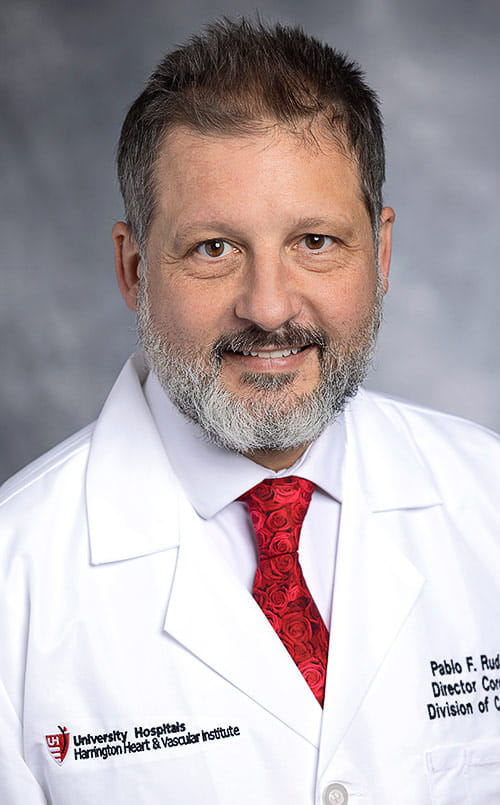Robotic Minimally Invasive Coronary Artery Bypass at University Hospitals Harrington Heart & Vascular Institute is Only One in Ohio
April 23, 2024
UH Clinical Update | April 2024
A new approach to coronary artery bypass graft (CABG) surgery is now being performed at UH Cleveland Medical Center. Surgeons are now using the Da Vinci robot to perform CABG through a minimally invasive approach. Patients who want to be considered for this new approach now have access to a new clinic within UH Harrington Heart & Vascular Institute that focuses on robotic cardiac surgery and minimally invasive CABG.
 Kelsey Gray, MD
Kelsey Gray, MD Pablo Ruda Vega, MD
Pablo Ruda Vega, MDThere are not many surgeons or cardiac surgery centers in the United States that are performing this type of surgery. Currently, Kelsey Gray, MD, and Pablo Ruda Vega, MD, are the only two surgeons performing robotic minimally invasive CABG in Ohio.
Why is this Type of Surgery So Uncommon?
Dr. Gray explains: “This surgery is technically challenging because it requires the surgeon to be facile both with the robot and with off-pump coronary artery bypass grafting. This younger generation of cardiac surgeons, like myself, get a significant amount of experience with robotic surgery during our training, but at the same time, there is a lot less exposure to off-pump surgery for us during our training than there used to be. I was very fortunate to train with Dr. Ruda Vega, who is a very experienced off-pump surgeon, which is why our program was uniquely positioned to start performing robotic minimally invasive CABG.”
Dr. Ruda Vega, Director of Cardiac Surgery at UH Lake West Medical Center, trained Dr. Gray on off-pump cardiac surgery during her cardiothoracic surgery fellowship at UH Cleveland Medical Center, drawing on his years of experience with the procedure. Dr. Gray, having had robotic training both in her general surgery residency and her thoracic surgery fellowship, was able to become certified on the robot and start performing robotic minimally invasive CABG. She performed the first robotic MIDCAB at the Louis Stokes Cleveland VA Medical Center around Thanksgiving of last year, with the first UH case just about a week later. Since then, she’s performed more than 30.
Benefits for Patients
The clear clinical advantages of MIDCAB are worth it for patients, Dr. Gray says. Patients avoid the pain and healing time of a sternotomy. They can return more quickly to driving, lifting and normal activities. Plus, the off-pump aspect of the surgery is beneficial for patients at higher risk, such as those with a calcified aorta, carotid disease, peripheral artery disease or chronic kidney disease.
On the technical side, cardiac surgeons can more easily do multiple grafts to the left side of the heart and can pursue a hybrid option when warranted – which means patients can get a combination of bypass grafting and PCI, such as left internal mammary artery (LIMA) followed by percutaneous coronary intervention (PCI) to non-left anterior descending artery (LAD) lesions.
The robot, too, offers its own set of advantages, Dr. Gray says. It allows the surgeon a longer skeletonized LIMA to work with when grafting and allows for ventilating the patient’s left lung for those who can’t tolerate single-lung ventilation. And there are even greater benefits than minimally invasive surgery alone in terms of post-operative pain, length of stay in the hospital and return to normal activities.
Shifting the Paradigm
Conversations are ongoing, but Dr. Gray says MIDCAB is also encouraging discussions among her colleagues about alternatives to stenting.
“This minimally invasive approach, whether it's with the robot or through the MIDCAB approach, has changed the way people view this,” she says. “We see improved mortality and reduced rate of re-intervention and a risk profile similar to complex PCI. It's much easier to make the case to these patients. We say, ‘You're going to live longer. You're going to do better. You're going to have more freedom from re-intervention, and you don't have to have a big sternotomy. So that's sort of where this conversation is going.”
National Leader in MIDCAB
As it stands, UH Harrington Heart & Vascular Institute is ranked #4 in the country for MIDCAB volume.
“We have become one of the biggest centers in the country because we are truly a team,” says Dr. Ruda Vega. “We have tremendous involvement from our cardiologists and cardiac surgeons, and I am grateful for the support of our leadership and colleagues.”
The new robotic program and patient clinic will only add to these impressive numbers.


